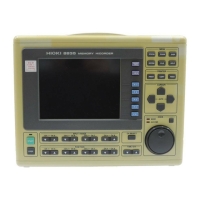What to do if the printed recording is non-existent on Hioki 8835-01 Measuring Instruments?
- SSavannah HoffmanSep 12, 2025
Check if the recording paper is back to front.

What to do if the printed recording is non-existent on Hioki 8835-01 Measuring Instruments?
Check if the recording paper is back to front.
What to do if the LED does not light when turned on Hioki Measuring Instruments?
Check if the power cord is connected properly.
| Channels | 1 |
|---|---|
| Bandwidth | DC to 100 kHz |
| Display | LCD |
| Interface | USB |
| Safety Standards | IEC 61010-1 |
| Power Supply | AC adapter or battery |
| Measurement Functions | Voltage, frequency |
Essential information and warnings for safe operation and maintaining safe condition.
Precautions for installation environment, power supply, and grounding.
Safety guidelines for probe connection and maximum input voltage ratings.
Lists key features including display, functions, trigger, printer, and interface.
Identifies and explains the function of front panel controls and indicators.
Provides guidance on installing and preparing the unit for measurement.
Instructions on how to install the unit and its orientation on a flat surface.
Details on connecting the unit to AC/DC power supply and proper grounding.
Instructions on how to turn the unit on and off, including warm-up.
Instructions for connecting various probes to the analog units.
Instructions for connecting logic probes to the unit's logic inputs.
Instructions for connecting the 9322 differential probe.
Important notes and warnings regarding measurement procedures.
Details maximum input voltage limits for various input units.
Covers basic operations and settings for measurement.
Describes main display screens, keys, and their functions.
Details the functions of JOG/SHUTTLE controls and the select key.
Instructions on how to start and stop measurements using START/STOP keys.
Example of measuring and recording a voltage using the Memory Recorder function.
Example of measuring and recording a voltage using the Recorder function.
Example of measuring and recording an RMS value.
Lists available waveform parameter processing functions.
Details calculations for parameters like average, RMS, peak-to-peak.
Detailed information on the Memory Recorder function.
Explains how to make various settings for the Memory Recorder function.
How to use the auto-range function to set time and voltage axes.
Overview of waveform parameter processing and calculation details.
Detailed information on the Recorder function.
Explains how to make various settings for the Recorder function.
Detailed information on the RMS Recorder function.
Explains how to make settings for the RMS Recorder function.
How to set the time axis range and sampling period.
How to set the recording length for a measurement.
How to enable automatic saving of RMS waveform data to disk.
How to select and configure trigger settings for capturing signals.
How to configure settings for input channels.
Instructions on how to start and stop measurements.
Details on configuring input channels for all functions.
How to select channels for use in the Memory Recorder function.
Explains settings for the 8936 Analog Unit.
How to set the voltage range for the display.
How to perform zero adjustment to calibrate the 0V position.
Explains settings for the 8937 Voltage/Temp Unit.
How to configure settings for voltage measurement.
How to configure settings for temperature measurement.
Explains settings for the 8938 FFT Analog Unit.
Explains settings for the 8939 Strain Unit.
How to perform auto-balancing for strain measurements.
How to set the zero position for strain measurements.
Explains settings for the 8940 F/V Unit.
How to set the unit for measuring frequency.
How to set the unit for measuring pulse duty ratio.
How to set the unit for measuring voltage.
How to set the unit for measuring current.
Explains settings for the 8946 4 ch Analog Unit.
Explains settings for the 8947 Charge Unit.
How to set the unit for measuring acceleration.
How to adjust sensor sensitivity for acceleration measurements.
How to set the measurement range for charge measurements.
How to set the anti-aliasing filter to prevent distortion.
How to configure settings for logic inputs.
Details trigger functions and their usage.
Overview of trigger functions and types of signals used for triggering.
How to determine the trigger mode for operation.
How to set pre-trigger for recording waveforms before and after triggering.
How to set the time relation to the waveform when a trigger occurs.
How to link trigger sources using logical operators (AND/OR).
How to use analog signal input channels as trigger sources.
How to set trigger level and direction for analog signals.
How to set trigger levels to detect signals entering or leaving a range.
How to trigger when voltage drops below a set level.
How to trigger based on measured period exceeding a set range.
How to trigger when RMS signal crosses a predetermined level.
How to convert sensor voltage to physical quantities using scaling.
Covers procedures for storing, retrieving, and deleting data.
How to use SAVE, LOAD, INFO, DELETE commands and manage directories.
Details trigger modes, sources, types, filter, and timing.
Covers logic and analog input units and their specifications.
Overview of analog input units.
Covers maintenance procedures for the unit.
Common problems and their solutions.